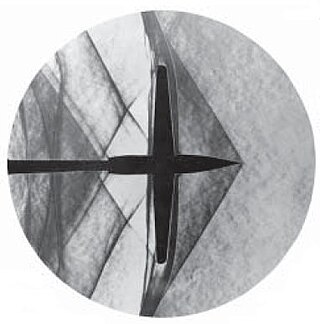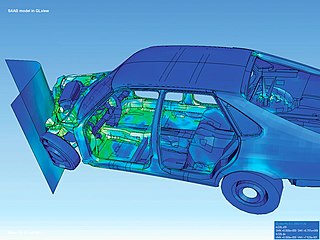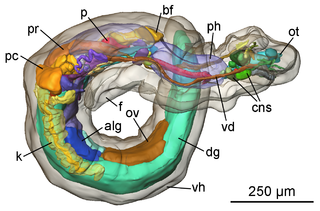
In 3D computer graphics, a voxel represents a value on a regular grid in three-dimensional space. As with pixels in a 2D bitmap, voxels themselves do not typically have their position explicitly encoded with their values. Instead, rendering systems infer the position of a voxel based upon its position relative to other voxels.

Schlieren photography is a process for photographing fluid flow. Invented by the German physicist August Toepler in 1864 to study supersonic motion, it is widely used in aeronautical engineering to photograph the flow of air around objects.

Scientific visualization is an interdisciplinary branch of science concerned with the visualization of scientific phenomena. It is also considered a subset of computer graphics, a branch of computer science. The purpose of scientific visualization is to graphically illustrate scientific data to enable scientists to understand, illustrate, and glean insight from their data. Research into how people read and misread various types of visualizations is helping to determine what types and features of visualizations are most understandable and effective in conveying information.

Visualization or visualisation is any technique for creating images, diagrams, or animations to communicate a message. Visualization through visual imagery has been an effective way to communicate both abstract and concrete ideas since the dawn of humanity. from history include cave paintings, Egyptian hieroglyphs, Greek geometry, and Leonardo da Vinci's revolutionary methods of technical drawing for engineering and scientific purposes.

In scientific visualization and computer graphics, volume rendering is a set of techniques used to display a 2D projection of a 3D discretely sampled data set, typically a 3D scalar field.
Particle image velocimetry (PIV) is an optical method of flow visualization used in education and research. It is used to obtain instantaneous velocity measurements and related properties in fluids. The fluid is seeded with tracer particles which, for sufficiently small particles, are assumed to faithfully follow the flow dynamics. The fluid with entrained particles is illuminated so that particles are visible. The motion of the seeding particles is used to calculate speed and direction of the flow being studied.

Reyes rendering is a computer software architecture used in 3D computer graphics to render photo-realistic images. It was developed in the mid-1980s by Loren Carpenter and Robert L. Cook at Lucasfilm's Computer Graphics Research Group, which is now Pixar. It was first used in 1982 to render images for the Genesis effect sequence in the movie Star Trek II: The Wrath of Khan. Pixar's RenderMan was one implementation of the Reyes algorithm, until its removal in 2016. According to the original paper describing the algorithm, the Reyes image rendering system is "An architecture for fast high-quality rendering of complex images." Reyes was proposed as a collection of algorithms and data processing systems. However, the terms "algorithm" and "architecture" have come to be used synonymously in this context and are used interchangeably in this article.

In information visualization and computing, treemapping is a method for displaying hierarchical data using nested figures, usually rectangles.

Velocimetry is the measurement of the velocity of fluids. This is a task often taken for granted, and involves far more complex processes than one might expect. It is often used to solve fluid dynamics problems, study fluid networks, in industrial and process control applications, as well as in the creation of new kinds of fluid flow sensors. Methods of velocimetry include particle image velocimetry and particle tracking velocimetry, Molecular tagging velocimetry, laser-based interferometry, ultrasonic Doppler methods, Doppler sensors, and new signal processing methodologies.
Texture synthesis is the process of algorithmically constructing a large digital image from a small digital sample image by taking advantage of its structural content. It is an object of research in computer graphics and is used in many fields, amongst others digital image editing, 3D computer graphics and post-production of films.

In computer graphics, a heightmap or heightfield is a raster image used mainly as Discrete Global Grid in secondary elevation modeling. Each pixel stores values, such as surface elevation data, for display in 3D computer graphics. A heightmap can be used in bump mapping to calculate where this 3D data would create shadow in a material, in displacement mapping to displace the actual geometric position of points over the textured surface, or for terrain where the heightmap is converted into a 3D mesh.

Flow visualization or flow visualisation in fluid dynamics is used to make the flow patterns visible, in order to get qualitative or quantitative information on them.

In computer vision and computer graphics, 3D reconstruction is the process of capturing the shape and appearance of real objects. This process can be accomplished either by active or passive methods. If the model is allowed to change its shape in time, this is referred to as non-rigid or spatio-temporal reconstruction.

Computer graphics deals with generating images and art with the aid of computers. Today, computer graphics is a core technology in digital photography, film, video games, digital art, cell phone and computer displays, and many specialized applications. A great deal of specialized hardware and software has been developed, with the displays of most devices being driven by computer graphics hardware. It is a vast and recently developed area of computer science. The phrase was coined in 1960 by computer graphics researchers Verne Hudson and William Fetter of Boeing. It is often abbreviated as CG, or typically in the context of film as computer generated imagery (CGI). The non-artistic aspects of computer graphics are the subject of computer science research.
In scientific visualization, Lagrangian–Eulerian advection is a technique mainly used for the visualization of unsteady flows. The computer graphics generated by the technique can help scientists visualize changes in velocity fields. This technique uses a hybrid Lagrangian and Eulerian specification of the flow field. It is a special case of a line integral convolution.

In scientific visualization, line integral convolution (LIC) is a method to visualize a vector field, such as fluid motion.

In scientific visualization, texture advection is a family of methods to densely visualize vector fields or flows. Scientists can use the created images and animations to better understand these flows and reason about them. In comparison to techniques that visualise streamlines, streaklines, or timelines, methods of this family don't need any seed points and can produce a whole image at every step.
Jarke J. (Jack) van Wijk is a Dutch computer scientist, a professor in the Department of Mathematics and Computer Science at the Eindhoven University of Technology, and an expert in information visualization.
This is a glossary of terms relating to computer graphics.
The IEEE Visualization Conference (VIS) is an annual conference on scientific visualization, information visualization, and visual analytics administrated by the IEEE Computer Society Technical Committee on Visualization and Graphics. As ranked by Google Scholar's h-index metric in 2016, VIS is the highest rated venue for visualization research and the second-highest rated conference for computer graphics over all. It has an 'A' rating from the Australian Ranking of ICT Conferences, an 'A' rating from the Brazilian ministry of education, and an 'A' rating from the China Computer Federation (CCF). The conference is highly selective with generally < 25% acceptance rates for all papers.















